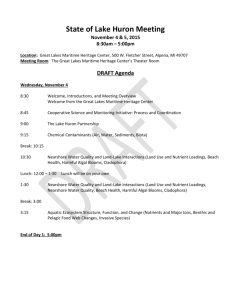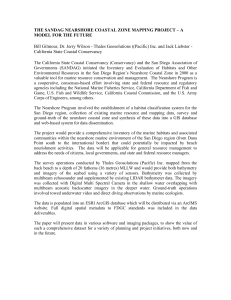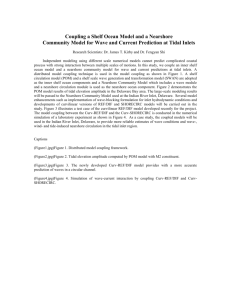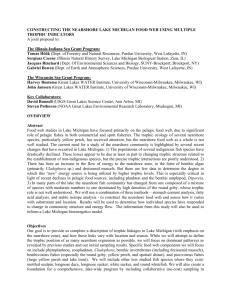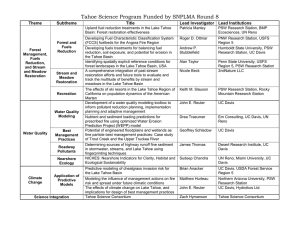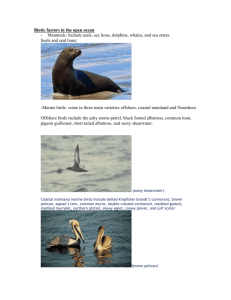Lake Tahoe Nearshore Evaluation and Monitoring Framework Report
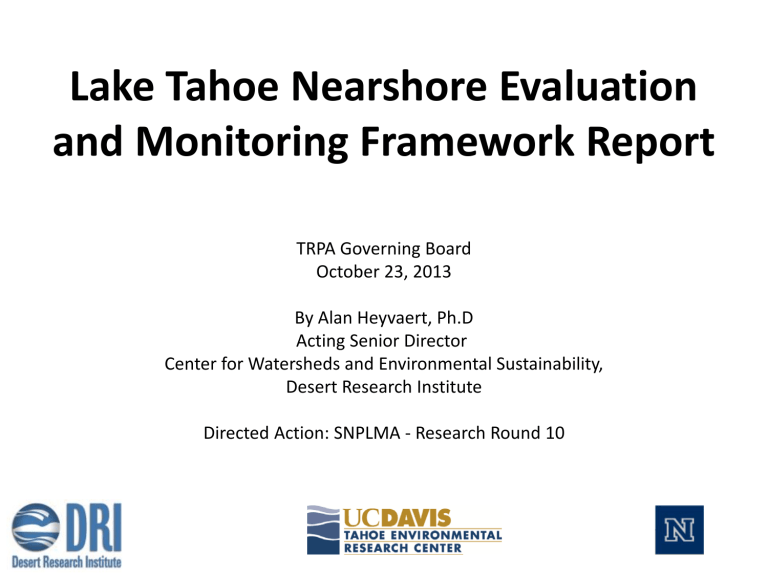
Lake Tahoe Nearshore Evaluation and Monitoring Framework Report
TRPA Governing Board
October 23, 2013
By Alan Heyvaert, Ph.D
Acting Senior Director
Center for Watersheds and Environmental Sustainability,
Desert Research Institute
Directed Action: SNPLMA - Research Round 10
SNPLMA Funded Research (Rounds 7 through 12)
$5,000,000
$4,500,000
$4,000,000
$3,500,000
$3,000,000
$2,500,000
$2,000,000
$1,500,000
$1,000,000
$500,000
$0
Erosion and
Stormwater
Management
Forest and
Fuels
Management
Science
Integration
(w/TSC)
Lake Water
Quality and
Invasive
Species
Air Quality Ecological
Communities and Wildlife
Habitat
Stream
Restoration
Managing for
Climate
Change
2
Contemporary Research Efforts - Nearshore
•
Inferring littoral substrates, fish habitats, and fish dynamics of Lake Tahoe using IKONOS data; TRPA
•
Nearshore clarity at Lake Tahoe: status and causes of reduction; NV LTLP
•
Predicting and managing changes in nearshore quality; SNPLMA-Round 7
• Monitoring past, present and future water quality using remote sensing; SNPLMA-Round 7
•
Niches: nearshore indicators for clarity, habitat and ecological sustainability; SNPLMA-Round 8, NV-LTLP
•
Development of a risk model to determine the expansion and potential environmental impacts of Asian clams; SNPLMA-Round 9, NV-LTLP
•
Warm-water non-native fishes in Lake Tahoe; NV-LTLP
• Potential for pathogen growth, fecal indicator growth and phosphorus release under clam removal barriers; SNPLMA-Round 10
•
Natural and human limitations to Asian clam distribution and recolonization-factors that impact the management and control in Lake Tahoe; SNPLMA-Round 10, NV LTLP
•
Linking on-shore and nearshore processes: nearshore water quality monitoring buoy at Lake Tahoe – phases I and II; NV LTLP
•
The ecology of curly leaf pondweed ( Potamogeton crispus ) and the potential for control using bottom barriers; SNPLMA-Round 11
•
Testing the survival and growth of quagga mussel in Lake Tahoe; SNPLMA-Round 11
• Evaluation of nearshore ecology and aesthetics (this project); SNPLMA-Round 10
Existing and Current Monitoring
•
Lake Tahoe water quality investigations: algal bioassay, phytoplankton, atmospheric nutrient deposition, and periphyton, 2000 to on-going; Lahontan,
UC Davis
•
Nearshore turbidity monitoring – various and intermittent efforts from 1965 to
2012; UC Davis, DRI, TRPA, NV LTLP
•
Tributary pollutant concentration and loading monitoring; TRPA, USGS, USFS,
UC Davis, NV LTLP
•
Aquatic invasive species – prevention and control measure implementation and effectiveness monitoring; Various
•
Shorezone ordninance effectiveness monitoring of gasoline constituents, fecal coliform, e. coli , and polycyclic aromatic hydrocarbons; USGS, TRPA, Lahontan
•
Watercraft monitoring; TRPA
•
Deep water Lake Tahoe Water Quality Monitoring, TRPA, UC Davis
•
Urban stormwater pollutant monitoring (nearing implementation); Lahontan,
USFS, Lahontan, TRCD
Project Overview
Nearshore Science Team (NeST) Contributors
Alan Heyvaert, Desert Research Institute (DRI);
John Reuter, University of California, Davis (UCD);
Sudeep Chandra, University of Nevada, Reno (UNR);
Rick Susfalk, (DRI);
S. Geoffrey Schladow (UCD);
Scott Hackley (UCD).
Technical Contributors
Christine Ngai (UNR), Brian Fitzgerald (DRI), Charles Morton (DRI),
Annie Caires (UNR), Ken Taylor (DRI), Debbie Hunter (UCD), Brant Allen
(UCD), Patty Arneson (UCD).
Nearshore Agency Working Group
Shane Romsos (TRPA), Dan Sussman (LRWQCB), Jason Kuchnicki
(NDEP), Jacques Landy (USEPA).
Project Overview
Background:
–
Long-term monitoring monitoring and assessment in Lake Tahoe historically focused on mid-lake conditions
–
Current nearshore monitoring insufficient to detect changing conditions
–
Needed a comprehensive, integrated assessment of existing conditions
Project Objectives:
–
Review and synthesize existing research and monitoring data
–
Document understanding of nearshore conditions
–
Review standards and indicators for relevance to nearshore condition
–
Develop an integrated nearshore monitoring design
Major Products:
–
Conceptual model and indicator framework
–
Assessment of exiting standards and indicators
–
Nearshore monitoring and evaluation framework
Nearshore Desired Condition
Statement
Lake Tahoe’s nearshore environment is restored and/or maintained to reflect conditions consistent with an exceptionally clean and clear (ultraoligotrophic) lake for the purposes of conserving its biological, physical and chemical integrity, protecting human health, and providing for current and future human appreciation and use.
Nearshore Definition (Monitoring)
We do not recommend any changes to existing state and
TRPA legal or statutory definitions of the Lake Tahoe nearshore. Rather, the following definition addresses unique aspects of the nearshore in the context of framing our monitoring design.
Lake Tahoe’s nearshore for purposes of monitoring and assessment is considered to extend from the low water elevation of Lake Tahoe
(6223.0 feet Lake Tahoe Datum) or the shoreline at existing lake surface elevation, whichever is less, to a depth contour where the thermocline intersects the lake bed in mid-summer; but in any case, with a minimum lateral distance of 350 feet lakeward from the existing shoreline.
The 31-year average August (maximum) thermocline depth in Lake
Tahoe is 21 m (69 feet).
Natural rim (6223 feet)
350 foot from rim
30 foot depth contour
69 foot depth contour
Illustration of Factors Affecting Nearshore
The nearshore conceptual model:
Important Controllable Factors that Influence
Nearshore Conditions
Implement TMDL
Stormwater BMPs
Remove/Disconnect
Impervious Cover
Control Shoreline
Development
Prevent/Control AIS
Stream & Wetland
Restoration
Reduce Vehicle
Emissions
Maintain Integrity of
Sewer Infrastructure
Reduce Fertilizer Use
Control
Measures t e g a s i t i
M
Urban Stormwater
Runoff
Contaminated
Groundwater
Excess Fertilizer Use
Impervious Cover
Infested Watercraft,
Aquariums
Domestic Animal &
Human Waste
Primary
Anthropogenic
Causes t e r a s n e
G e
Sediment
Nutrients
Aquatic Invasive
Species
Pathogens and
Toxins
Pollutants and
Invasive Species c t s f e f
A
Clarity
Trophic Status
(Oligotrophy)
Biological
Community
Composition
Human Health
Indicators of
Nearshore
Health
Assessment of Existing Standards
1. Agency representatives provided a list of existing standards (TRPA,
NDEP, LRWQCB).
2. NeST sorted these standards into 38 categories with internally similar characteristics (Appendix A).
3. Brief narrative descriptions were developed for each category, along with preliminary data assessment (from bibliography) and a discussion of relevance to nearshore management or monitoring
(Appendix B).
4. Categories of existing standards deemed “important” or “relevant” to both nearshore management and nearshore monitoring were carried forward and aggregated into a smaller list of internally related characteristics (Table 6-1).
5. A subset of this attribute list provided the basis for design of the integrated nearshore monitoring framework.
Table B-1. Existing Standards Potentially Relevant to the Nearshore of Lake Tahoe.
Evaluation of Existing Standards
1 See Appendix B for discussion of referenced standards
Indicator Framework for Monitoring
Standards, Indicators and Metrics
Nearshore Monitoring Data Support for
Existing Standards Evaluation or Revision
Periphyton
(remember N&P and not fine sediment controls growth)
Nearshore Conditions are Spatially and Temporally Variable
Nearshore Monitoring Design
Next Steps
•
Public Engagement
•
Monitoring Program
•
